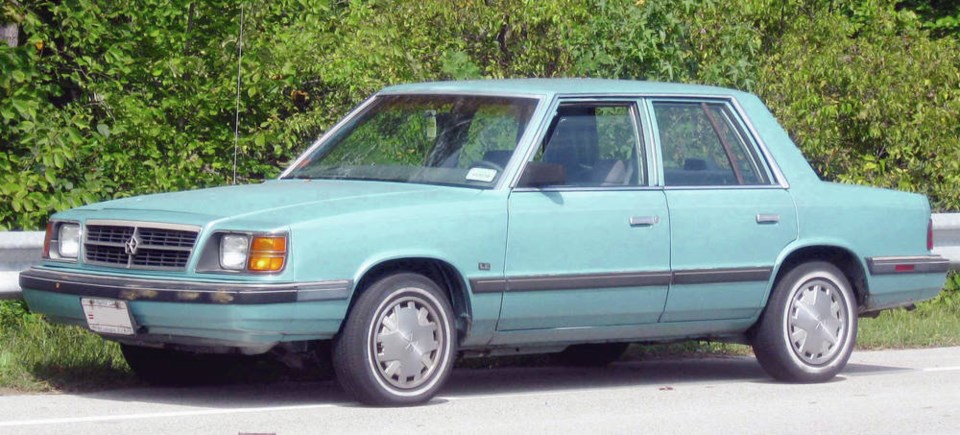Lido (Lee) Iacocca achieved what few men have: he saved an automobile company from bankruptcy. In rescuing the Chrysler Corporation during the 1979 to 1982 period he displayed the same drive and spirit that Chrysler’s founder Walter P. Chrysler had showed 60 years earlier when he was commissioned to save Willys-Overland.
But Chrysler had greater ambitions. When then was hired to rejuvenate Maxwell Motors Corp. he also saved it, then turned it into the Chrysler Corp. in 1925.
But good management only goes so far; a man needs sound products too. And just as Walter Chrysler had the “Good Maxwell,” Iacocca had the front-wheel drive K-car Dodge Aries/Plymouth Reliant twins.
No product in modern automotive history was so extensively previewed nor had so much resting on its square-cut shoulders. The somewhat plain looking K-car became Iacocca’s corporate rescue weapon.
All American automakers were caught in the market gyrations of the turbulent 1970s, a decade of two “oil crises” and tightening fuel economy, emissions and safety standards. There was also increasing foreign competition and buyer demand that fluctuated between small and large cars. Chrysler suffered badly in this vacillating market.
Chrysler’s response to 1970s small-car demand was to import Japanese Mitsubishi products and market them with names like Dodge Colt and Plymouth Champ. This gave them time to produce their own cross-engine, front-wheel drive Volkswagen Rabbit (Golf) type subcompacts, the 1978 Dodge Omni and Plymouth Horizon.
While the Omni/Horizon filled an important market segment, Chrysler needed cars that were larger but still economical, a prediction vindicated by the 1979 energy crisis. So as the Omni/Horizon design neared completion in 1976, Chrysler began engineering a larger front-wheel driver code-named K-car.
While the sub-compact Omni/Horizon certainly helped Chrysler, the company still lost $1.1 billion U.S in 1979, the biggest loss in U.S. history to that time. It would take a special person to rescue it.
Fortunately for Chrysler an experienced car man was available. Henry Ford II, whether out of jealousy or dislike, had recently fired Lido (Lee) Iacocca after 32 productive years with Ford Motor Co. He was invited to join Chrysler, which he accepted on the condition that he start as president and soon become chairman.
He was now 55 and as he noted in his 1984 book, Iacocca, an Autobiography, “At this point in my life, I had no interest in working for somebody else.”
In seeking company-saving government loan guarantees, Iacocca and his management team, some of them ex-Ford employees, were required to reveal the product the loans would be used for. Thus the K-car, which Iacocca had enthusiastically embraced upon arrival, became so widely exposed that its official debut as a 1981 model would seem almost anticlimactic.
The K-car came as a squared-up two- and four-door sedan and four-door station wagon. Despite a reported 300 wind tunnel hours the angular profile yielded an unimpressive 0.51 aerodynamic drag coefficient.
It had a shortish 2,530 mm (99.6 in.) wheelbase and was 4,445 mm (175 in.) long overall. This was 135 mm (5.3 in.) less wheelbase and 152 mm (6.0 in.) less length than the 1980 GM front-drive X-cars (Chevrolet Citation, Pontiac Phoenix, et al.) but the rectangular shape provided virtually the same interior space. Chrysler called it a six-passenger car although five were more comfortable.
Power came from a Chrysler-built, transversely mounted 2.2 litre, overhead camshaft, four-cylinder engine. Its 84 horsepower drove the front wheels through a standard four-speed manual or optional three-speed automatic transaxle. A Mitsubishi “Silent Shaft” 2.6 litre, 92 horsepower four was optional.
The unit-construction K-car was straightforward mechanically with MacPherson struts in front and a rear beam axle and coil springs. It weighed just over 1,089 kg (2,400 lb). Despite this rather appliance-like approach the Aries/Reliant proved to have a heart of gold.
Chrysler survived by selling some 410,000 1981 K-cars, compared with the 195,000 rear-wheel drive Dodge Aspen/Plymouth Volares they replaced. By 1983 Iacocca proudly paid off Chrysler’s $833 million (U.S.) loan guarantees.
Chrysler then proceeded to spin off so many K-car derivatives it became almost an industry joke. But Iacocca had the last laugh because the 1984 Dodge Caravan and Plymouth Voyager minivans, which also used K-car components, were fabulously successful. These ideal family vehicles scooped the U.S. auto industry and firmly consolidated Chrysler’s comeback.
The original K-car was replaced in 1989 by the Dodge Spirit/Plymouth Acclaim. Iacocca, who retired from Chrysler in 1992, had established his name as a company rescuer alongside such giants as General Motors’ Alfred P. Sloan, Jr., Walter Chrysler himself, and more recently Ford’s Alan Mulally
Lee Iacocca died on July 2, 2019 at age 94 at his Bel Air, California, home. This father of the Mustang and saviour of Chrysler was a titan of the industry.



